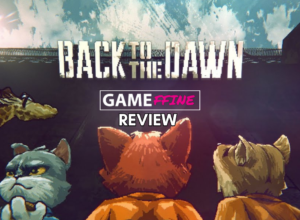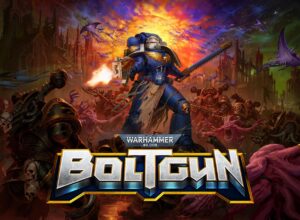I have been a fan of survival games for a long time, ever since I started with ARK: Survival Evolved and Rust. Perhaps this is because I had my squad to back me up in grueling situations and never-ending grind. Survival can be tough, with some people trying to act like trolls of the servers while others become grievers for no reason other than amusement. Amongst all this toxicity, one game wants to stand out and make the genre great again. Ancestors: The Humankind Odyssey details how humans evolved over 10 billion years ago.
Ancestors: The Humankind Odyssey is a third-person open-world survival game published by Private Division and developed by Panache Digital Games. The game is currently out on the Epic Games Store and is scheduled to come to Steam sometime later in 2020.

Ancestors: The Humankind Odyssey
Detailed Review
Story & Narrative
The game does not have a story as such. Instead, the game allows you to carve out your own story on stone (or pillars or bones of dead creatures, whatever floats your raft). The game states during the prologue that evolution did not have a story, but was a gradual process forged by humanity on their own over the years. You design your own experience based on how you want to see yourself and the world. With that being said, the game does have quite some rich lore around it, so you’ll be busy unearthing each and every piece and putting them together.

Being a game from developers who had AAA experience to their name, Ancestors: The Humankind Odyssey plays differently from other survival games. The amount of polish is certainly something different for a survival game, most of which were low budget early access titles with quite a few bugs and technical issues to their name. Also, Ancestors tries to carve out a worthy singleplayer experience, something which is quite lacking in most other survival games. With that being said, while multiplayer (or some amount of coop) would certainly be a decent addition, the game doesn’t have it simply because the game world (and the ecosystem) is not large enough to support it. The developers decided to allow people to stay away from others (and from the toxicity in general) – to decide their own experiences without any form of external interference. (and it was a beautiful decision, to say the least).

Gameplay and Mechanics
The prologue has a pretty stringent instruction set for what’s going to happen in the game as a whole. You are going to live through the early days of humanity when we were a bunch of apes (or hominids, if you prefer a better term). Make important discoveries, forge tools, discover the landscape and evolve the bunch of monkeys. The game starts in 10,0000,000 BC in the newly formed continent of Africa. A wild ecosystem consisting of a variety of creatures was a part of the various biomes on the continent. A time when humanity wasn’t at the top of the food chain.

The game’s main focus isn’t on one hominid, or even a clan of hominids, but their collective mental presence as a whole. You address humanity’s earliest ancestors – every one of them. The game allows you to take control of any hominid within your clan (whose main objective) – be it a male, female or even a child. The cognitive capabilities of children obviously differ from those of a fully grown adult (which becomes even more prominent after a little progression in the skill tree). Children hold the secret to evolution, which often results in desirable or non-desirable traits being added to the genome. Children add neuronal energy which is needed for evolution and further development of the genome. (The only way to “harvest” this energy is to give your clan’s young ones a ride).
The game allows players to interact with the environment in several creative ways. This becomes even more apparent once you unlock the ability to use both hands to hold an object. Certain objects can be altered to produce something else, which allows a large number of different interactions with it. (If you want a vanilla experience without any hints thrown at you, do not read the next section.) Repeatedly beating a stick creates a sharpened stick, which in turn, can be used to fish at a fishing spot in a river. Using stones to strike cocos allows you to drink the sweet water inside it. Tapok fibres can be used to get rid of injuries. (There we go, now you can read freely again).

There are many items to be made, and many to be discovered (a general rule of thumb is to go exploring – you’re sure to come across weird stuff on the way). The game does not give it all to you – you need to discover them on your own. Each object further has its uses, which is exactly what makes the concept of “discovery” so exciting. I won’t ruin your experience by mentioning any more uses, especially if you want to make your experience truly worth it.
The game’s tech tree is perhaps one of the most detailed I have seen in any survival game. It is basically an evolving neuron, showing off the structure of the genome, which grows with the completion of certain activities and the accumulation of neuronal energy. Neuronal energy comes from spending time with children, which in itself is quite dangerous since the world is filled with predators all around (and somehow hominids are at the absolute bottom of the food chain). With time – with a more expanded neuron and with a greater number of discoveries, hominids do manage to craft basic tools and use them to their advantage. A greater variety of construction options also become available gradually, as you meddle with more stuff. Discoveries are, in turn, facilitated by new genes added to the genome in the growing neuron.

The game also lays quite some focus on the day-to-day lives of the hominids. Every hominid needs to eat, drink and sleep to replenish their meters as part of their daily regime. There are several sources of food to eat, including berries, fruits, edible leaves and plants and later, even meat. The hominids even have their own sexual needs, which arises from the need to bond with each other. Mating actually helps further the genome too, often resulting in mutations in the children, some of which help them survive in an ever-evolving world. Realism is a key element of Ancestors, making every aspect of “surviving out in the wild” thrilling. Food may be spoilt, leading to digestion problems. Predators might attack and injure you, forcing you to find ways to heal yourself. Some predators (especially the mamba snake) have poison, posing another challenge if you get bitten.
Evolution is the key to victory. Humans had ascended to the top of the food chain through their intelligence and through the process of evolution alone. Evolution happens through special “evolution feats” – a basic ledger of events that humans accomplished in time. With each evolution feat, the clock turns, allowing your group of hominids to evolve. Use a tool, construct some stuff, eat some food, inspect for food quality, bait out predators or even explore the environment – everything counts.

The game’s AI is one of the best things I had noticed in recent times. Ancestors is a full simulation of an ecosystem in itself. Nothing happens if you stay perched on a tree and observe the changes going on down below. In fact, the game some times encourages you to do so. If you intimidate or somehow get a predator to follow you, and you lead it to another predator, you can observe that a fight breaks out between them, allowing the stronger to survive. This is an evolution feat – meaning that you are bound to come across it at some point or another. Note that in the early hours of the game, I followed this strategy only, making a python kill many a tiger that chased my brood of monkeys away from their home. This also allows you to harvest food from its carcass and eat it, further developing your diet. You can observe warthogs coming to drink water near the jungle streams and birds preying on the fish that lives inside the water and sometimes, even predators like snakes and tigers roaming around in search of prey (just stay up in your tree, they cannot climb trees).

Sounds and Music
Sounds are part of what makes the game so good. The game’s Intelligence system, which allows you to sense the environment around you is based on the sense of smell and hearing. Since I wasn’t using a VR headset with the capability of delivering the feeling of smell, I preferred to judge the system based on the sounds only. Sounds help you sense a predator or any other creature from quite a distance, and it also gives an idea about the environment around you. The game actually repurposes the sound as a game mechanic – a particularly impressive feat.
The game’s music is brilliant and enhances the aura created by the environment. It’s not something you can describe in words, but only feel, and definitely something which you can keep doing for hours.
Graphics and Performance
The game boasts of beautifully designed worlds where one can observe the environment for long hours on end (too bad it’s a survival game). The game has different biomes all around with different names to uniquely identify them, each carefully designed to be as accurate to their theme as possible. Even the models used in the game are extremely detailed, making it quite a pleasure on the eyes.
The game was run on the following system specifications:-
CPU: Ryzen 5 2600
GPU: GTX 1080
RAM: 16 GB DDR4
Despite the intricate details of the environment, Ancestors is an extremely well-optimized game, pulling well above 60 frames on the highest settings. The game does have some bugs though. I found some missing text on the hints in my playthroughs, which is quite an embarrassing mistake. The game also has some problem with awkward traversal occasionally, where the hominid you are controlling has some problem in grabbing ledges while climbing the trees or any other surface that can be climbed on. It becomes quite an issue especially when you’re on the run for a predator (I’m lucky not to have punched my monitor). There are some graphical glitches in the display of points of interest in the Intelligence mode (basically all points are not aligned in the same plane as the character). Oh, and mating didn’t work properly – the event never triggered. The mating issue seems to have been solved just prior to release, so I guess all’s good here.
Verdict
Ancestors: The Humankind Odyssey is a well-made survival game that can feel unforgiving and a bit repetitive at times, but manages to be the Sui generis of the genre by trying to carve out a place for itself in the world. It’s something fans of the genre should buy day if you’ve got nothing against the Epic Games Store. For others, it’s going to be a long wait till 2020.





